The monocular is a device that can be used with only one eye to see things at a greater distance. Like binoculars, these devices are usually made of plastic or metal.
The affordable cost of these devices makes them a good buy, and the unique perspective they offer can provide interesting views of the world. However, using one is slightly more involved than a simple point and shoot device.
In this article, we’ll take a deep dive into how to use monoculars, what they’re used for, and cover details on how to set one up.
What Is a Monocular Good For?

When using the device appropriately, a monocular telescope can aid in many uses. Below is a list of just some of the day to day uses of this higher magnification tool:
- Monoculars are useful in tracking and watching wildlife, but require some knowledge of animal behaviour to get the most out of this device.
- Monoculars are very useful for hunting as they can be used to scan the surroundings for targets. This device also offers a very wide field of view which allows you to track an animal without being in danger of losing sight of it.
- The monocular is also used by search and rescue teams to spot people in trees or on cliffs who may have fallen or are trapped in inaccessible locations where they cannot be reached.
- Monocular use has also been employed by scouts, pilots and other outdoor enthusiasts as a useful way of spotting wildlife through forests, mountains and valleys.
- You can use a monocular to look at the night sky more clearly, although the stars may not appear as bright as they would through a telescope. This is done by using the moon in full phase, which will act as a light source so that you can see the hundreds of stars that usually disappear from view with the naked eye.
- Monoculars are used for leisure sporting events such as for watching horse racing, bird watching and flightseeing.
- Monoculars are also used in conjunction with binoculars and telescopes as spotting scopes.
- A good monocular can be used to view celestial bodies like the sun, moon and planets. Monoculars are popular among amateur astronomers because they can be transported more easily than telescopes and are less prone to vibration problems during astrophotography.
- They can also be taken on treks due to their compact size, even when compared to a small telescope (usually 20–30 cm long). Telescopes are also more valuable and can be more easily damaged than monoculars.
- Due to their wide field of view, monoculars are even used as a form of low-cost “distant vision” instruments for patients with macular degeneration.
Using a Monocular, Basic Steps

Below we discuss some easy methods on how to use a monocular for best results. The basic steps are as follows:
- If you wear glasses, put them on.
- Remove the lens cap and ensure the lens is free of dust and dirt. Safely clean if necessary using a microfibre cloth. These are extremely delicate lenses, so avoid kitchen towels and rough tissue like toilet paper.
- Face yourself in the direction of the target.
- Unlike binoculars, monoculars are meant for use with one eye. Bring the ocular lens up to your dominant eye, but don’t let the rubber end touch your eyes. If you wear glasses, using the monocular press lightly against your glass lens.
- If you haven’t used monoculars before, switch from one eye to the other eye to see which provides the best view. After all, a monocular is one half of a binocular, so use this to your advantage to see if one eye is stronger than the other.
- Use the other hand to secure a firm and proper grip along the length of the monocular.
- Adjust the focus using the rigid barrel so that the entire field of view is in focus.
- Search for targets and objects in the view by moving your head slowly in sync with the monocular, especially if you’re trying to follow a moving object.
- Identify your targets/objects and, if necessary, gauge your distance from them by their size and position relative to other objects in their surroundings (like surrounding terrain).
- Bring the target object into the centre of the field of view and maintain focus.
- Focus on the target object until you can see it in your monocular image clearly.
How Do You Set Up a Monocular?

Most optical instruments, including binoculars and monoculars, require some tweaking from time to time to get a good image. If the images are blurry or have an exposed edge, you may need to adjust your eyepiece diopter or other lens controls. Below we discuss some easy methods on how to set up a monocular for best vision.
Adjust The Focus
Locate the object you want to look at, adjust the focus of your monocular so that you see a bright ring around it and then look through the eyepiece until it is centered in your field of view. Now move your monocular in front of your eye until it focuses directly on the target you want to see, and then move it back again. Make adjustments and repeat the process until you can see the object in your monocular clearly.
There are some things to consider when using a monocular: focus will be lost if you move your eye, or you must have something very close to your eye to be in focus, such as a tree branch. Another thing to consider is that when you move the monocular away from your eye and then back again, there is a time lag while the device re-focuses and is ready for use again.
Adjusting Aperture
Suppose you notice that star points appear dim and hazy and fainter in different positions in the eyepiece than they appear at infinity when looking through the eyepiece. In that case, it is likely that you have a set screw called an “aperture” in your focus system that needs adjusting.
In most high-quality monoculars, this can be adjusted with the supplied hex key, and any decent monocular will have a diagram in the instruction manual to help you. The eyepiece should move in and out smoothly without being over-tightened, as this will damage your monocular tube and make it harder to focus. Occasionally, one or both eyepieces may become loose in the ocular housing, which is easily remedied by tightening the screws that hold them in place.
Alignment Considerations
Monoculars can be handheld, attached to an arm (such as those often used to mount cameras in helicopters and small boats), or mounted on the telescope eyepiece tube. Mounting, however, is subject to optical alignment problems; a correct alignment can only be obtained with an instrument that allows adjustment of its intersecting points exactly at right angles. It is therefore recommended that a professional optician aligns all monoculars before using them for astronomical purposes – apart from aligning eyepieces for simple terrestrial use.
Understanding Lenses
The field of view that these devices offer is linked both to the diameter of the front glass and how close you are to your target. This means that the monoculars which offer the widest field of view will have lenses with larger diameters and therefore be more expensive.
Practice Makes Perfect
Using a monocular requires hand-eye coordination, which can be achieved through practice on small objects like coins and ping pong balls or by playing sports like golf or cricket. This may seem like a difficult task but is easily attained with some patience.
Types Of Monocular

Monoculars come in two types: adjustable and fixed.
Adjustable monoculars have a diopter correction lever attached to the eyepiece, which allows adjusting the eye relief, helping to avoid eye strains and blurring caused by excessive viewing near the edge of the field of view.
A fixed-focus monocular does not have diopter correction and is supplied with an extra objective lens on the eyepiece for this purpose. In general, both types of monoculars offer a similar field of view. Still, adjustable ones offer easier adjustment so that they can be used over a longer period, primarily when artificial light sources are used at night or during bad weather conditions, where it is difficult to see clearly what is being viewed.
Conclusion
The reason why many people are attracted to a monocular is because they provide a different perspective on their surroundings that allows viewing in magnification unattainable at distances to the naked eye.
Monoculars make impressive gifts for birthday or holiday presents. Most monoculars come with comprehensive instructions, but not everyone knows how to get the best results in real-world scenarios.
Hopefully, this article opens up some insight into how to use a monocular. Please feel free to comment below on your experiences, uses and hobbies that involve the use of a monocular.
Additional Resources
Sources and References
- Monocular and Binoculars – visionaustralia.org
- 3 Ways To Use a Monocular – wikihow.com
Sam loves to learn about animals and their habitats. He has been a nature lover from a very young age, and has been writing papers and articles about wildlife for as long as he can remember.
